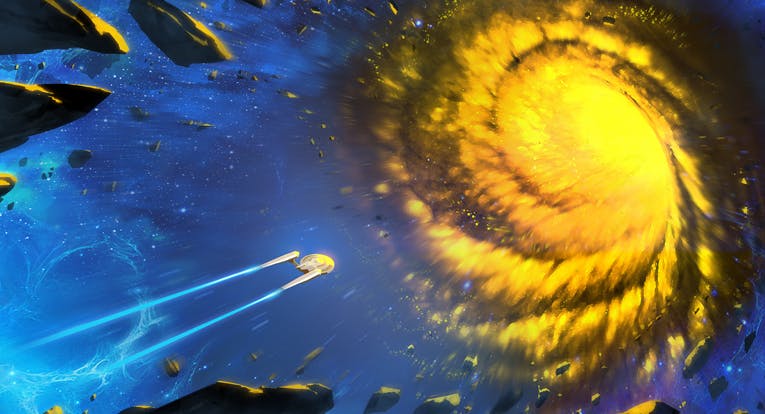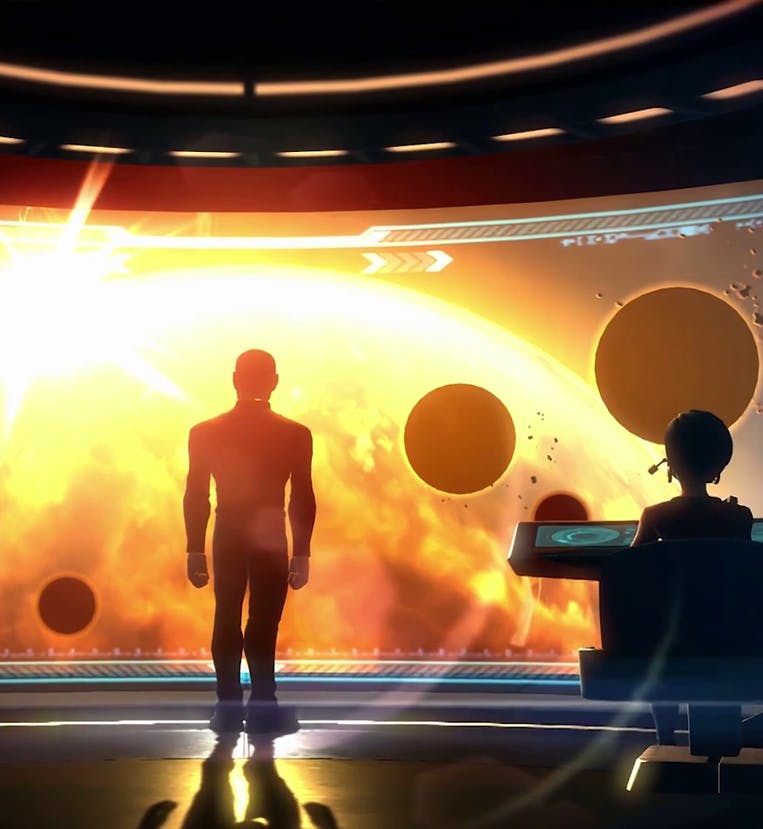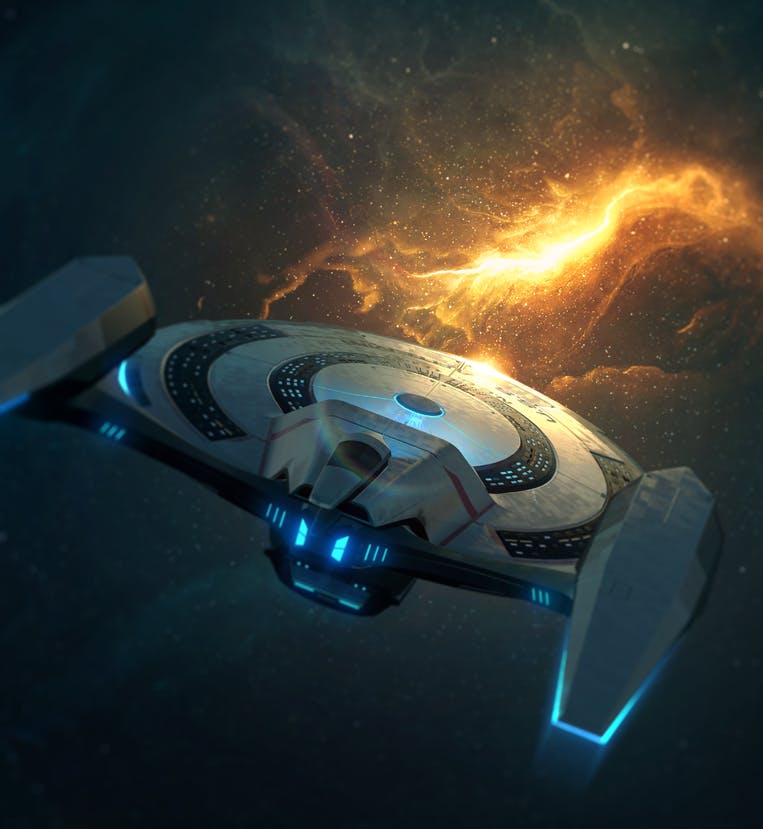Published Apr 2, 2021
Enter the Nexus With Star Trek: Legends
Going behind the scenes in the development of this brand new game.

StarTrek.com
When we first kicked off conceiving Star Trek: Legends, we knew we wanted to follow the series’ focus on characters. There are so many spectacular Star Trek heroes and villains that have kept us captivated through the years, and we really did not want to leave anyone out. But how do you gather all these individuals from different timelines, quadrants and even worlds into one setting? With the help of our friends at CBS, we started scouring the history of Star Trek for technologies, phenomena, and powers that could serve as a playground for bringing the likes of Kirk, Janeway and Odo shoulder-to-shoulder.
Perhaps our answers lay with the Talosians? Introduced in the original pilot episode of Star Trek: The Original Series, the Talosians possess incredible mental powers that allow them to create a manner of illusion so powerful, that it borders on reality. Our players could potentially find themselves as part of an elaborate illusion where they interact with their favorite characters. We toyed with the idea for a while but struggled with the fact that everything the Talosians create will be just an illusion. We wanted the encounters characters faced to have real gravity and for their quest to uphold the principles and values of the Federation and Starfleet to result in actual stakes. An illusionary world just would not do.

StarTrek.com
Along similar lines, we ruled out the Holodeck as our major plot device. Although Daniel Davis’s Moriarty had proven it is possible for Holodeck programs to cross into reality, he was the exception rather than the rule, and we didn’t want to give players the sense that everything they’re doing is just part of a holo novel and has no real implications.
The final bullet on our list was Q – the deus ex machina for every event and occasion across the four quadrants and beyond. It is well within Q’s powers to bring all Star Trek characters together for a thrilling adventure. But Q had been exhausted in creating these reality-bending scenarios, and he deserved a break. We decided to let him be.
So where does a game development team go from here? We didn’t want to give up our vision of letting fans go hands-on with their favorite characters through epic adventures!
That’s when we remembered the Nexus. First introduced and last touched on in Star Trek Generations, the Nexus is an extra-dimensional realm providing a utopian world to any who enters it. To cross into the Nexus, though, one must go through a destructive energy ribbon which decimates anything in its path. The dichotomy between the ruin the Nexus brings and the comfort entering it provides was compelling to us, as was the fact that within the Nexus anything can happen.
The Nexus has not been revisited on the screen since Star Trek Generations, so we didn’t learn much about it. Is it just a natural phenomenon? What is the reason for its destructive rifts? Why does every person who enters it find themselves in their own heaven? The effect of the Nexus – this utopic world it creates for you – seemed like a good place to start our deep-dive into the nature of this realm. It seemed to us like a phenomenon created by design. Isn’t that something everyone wishes they had – a place to escape death and live in eternal bliss? It definitely seemed any mortal civilization would eagerly create a machine of this variety if they possessed the right technology.
So let’s say an alien race did create the Nexus as a way to provide an “afterlife” for those who are ill or dying. They created this realm outside of our time and space, where there’s infinite room for each individual to have their own utopian reality. Picture a universe full of planet-sized “Spheres,” each of them housing an entire universe that revolves around a single person. They’re all connected to enormous “Engines,” powering the individual Spheres and keeping the realities running smoothly.
This direction led to some interesting moral and ethical questions. For example: do members of this society have a choice in entering the Nexus when their end is near? Is it a basic right afforded to everyone, or a luxury reserved for individuals of a certain status? We also wondered about the realities created in each of the Spheres, and if they’re illusions or a fully fleshed-out existence with actual people. These questions marked the great potential for storytelling the concept had, and the variety of scenarios we could create for players and their characters to tackle.
The next step in bringing the Nexus into our game was to figure out the conflict we seed to involve players. The obvious threat was the rifts: where did they come from? Why would they be integrated into the design? Well, like any elaborate technological construct, there’s room for error, degradation over time and… potential sabotage. Something is happening within the Nexus that is causing its walls to break down. It would have started long before the events of Star Trek Generations, where the Nexus rifts were a known phenomenon, and it’s becoming more and more of a threat.
That’s how we went about establishing the true nature of the Nexus and the reason behind its rifts, as well as seeding the conflict that will be at the heart of our players’ mission. Obviously, all those details are unknown to the Federation and the players, but as the rifts become more frequent, the Federation cannot sit idly by. They must investigate and understand the rifts and put a stop to the destruction. Star Trek Generations established that travel into the Nexus isn’t a simple matter, but it would stand to reason the Federation has been hard at work understanding more about it. When the events of Star Trek: Legends begin, the Federation is finally successful in constructing a starship – the U.S.S. Artemis - capable of withstanding the power of the rift and traversing the Nexus. At least, theoretically.
And that is where we are bringing the player in. The maiden voyage of the U.S.S. Artemis is a perilous one. No one knows what awaits on the other side of the rift and how the ship and its crew will be able to come back from the Nexus. If there ever was a mission you would “boldly go” on, this is it. As captain of the U.S.S. Artemis, we are immediately casting the player as a true model of a Starfleet officer: stalwart in the face of danger and committed to the greater good in the face of immense risk.

StarTrek.com
It won’t be long before the player learns of other Starfleet officers that have been pulled into the Nexus from other eras of Star Trek history. The Nexus is not bound by our principles of time and space, and you start the journey ignorant of the circumstances that have led to this time-spanning union. It’s a considerable part of the overall mystery as you and your crew delve deeper into the origins of the extradimensional realm.
That’s not to say everything about your adventure in the Nexus will be alien and shrouded in mystery. We’re using the liberty it affords us as a realm consisting of multitudes of realities to tell self-contained stories and even follow up on old plots that have become iconic to Star Trek fans. The Gorn captain wants a rematch, Kirk!
We can’t wait for you to visit our interpretation of the Nexus and unite with old and new friends. The best part of it is that through your feedback, we can continue to shape it into an experience that will spark your imagination and leave a lasting impression on fans.
Star Trek: Legends brings together your favorite heroes and villains in an epic adventure through the Nexus! It's available now on Apple Arcade.

